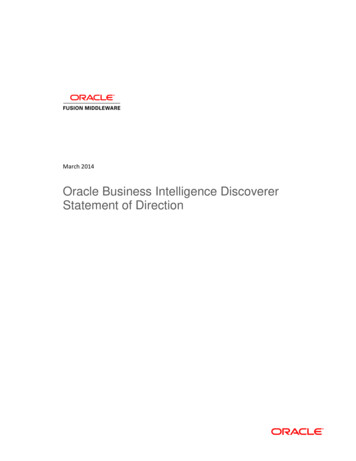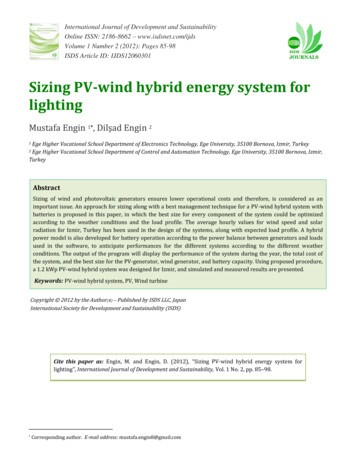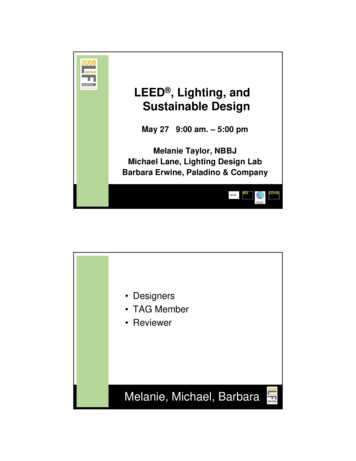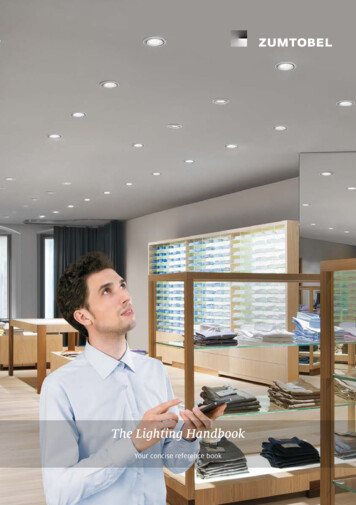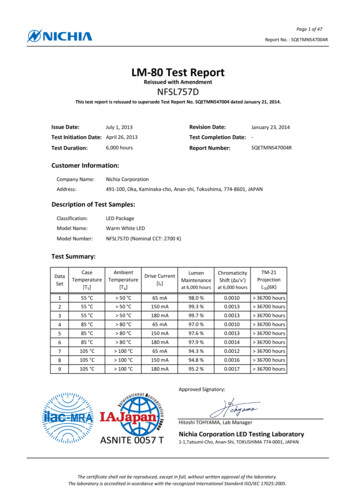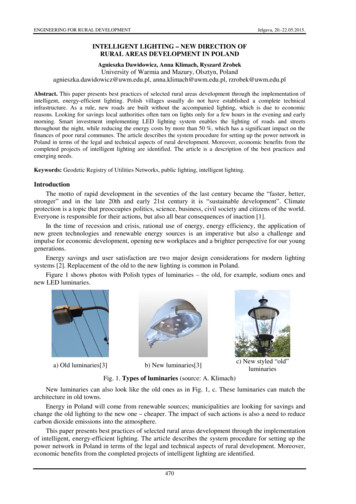
Transcription
ENGINEERING FOR RURAL DEVELOPMENTJelgava, 20.-22.05.2015.INTELLIGENT LIGHTING – NEW DIRECTION OFRURAL AREAS DEVELOPMENT IN POLANDAgnieszka Dawidowicz, Anna Klimach, Ryszard ZrobekUniversity of Warmia and Mazury, Olsztyn, Polandagnieszka.dawidowicz@uwm.edu.pl, anna.klimach@uwm.edu.pl, rzrobek@uwm.edu.plAbstract. This paper presents best practices of selected rural areas development through the implementation ofintelligent, energy-efficient lighting. Polish villages usually do not have established a complete technicalinfrastructure. As a rule, new roads are built without the accompanied lighting, which is due to economicreasons. Looking for savings local authorities often turn on lights only for a few hours in the evening and earlymorning. Smart investment implementing LED lighting system enables the lighting of roads and streetsthroughout the night, while reducing the energy costs by more than 50 %, which has a significant impact on thefinances of poor rural communes. The article describes the system procedure for setting up the power network inPoland in terms of the legal and technical aspects of rural development. Moreover, economic benefits from thecompleted projects of intelligent lighting are identified. The article is a description of the best practices andemerging needs.Keywords: Geodetic Registry of Utilities Networks, public lighting, intelligent lighting.IntroductionThe motto of rapid development in the seventies of the last century became the “faster, better,stronger” and in the late 20th and early 21st century it is “sustainable development”. Climateprotection is a topic that preoccupies politics, science, business, civil society and citizens of the world.Everyone is responsible for their actions, but also all bear consequences of inaction [1].In the time of recession and crisis, rational use of energy, energy efficiency, the application ofnew green technologies and renewable energy sources is an imperative but also a challenge andimpulse for economic development, opening new workplaces and a brighter perspective for our younggenerations.Energy savings and user satisfaction are two major design considerations for modern lightingsystems [2]. Replacement of the old to the new lighting is common in Poland.Figure 1 shows photos with Polish types of luminaries – the old, for example, sodium ones andnew LED luminaries.a) Old luminaries[3]b) New luminaries[3]c) New styled “old”luminariesFig. 1. Types of luminaries (source: A. Klimach)New luminaries can also look like the old ones as in Fig. 1, c. These luminaries can match thearchitecture in old towns.Energy in Poland will come from renewable sources; municipalities are looking for savings andchange the old lighting to the new one – cheaper. The impact of such actions is also a need to reducecarbon dioxide emissions into the atmosphere.This paper presents best practices of selected rural areas development through the implementationof intelligent, energy-efficient lighting. The article describes the system procedure for setting up thepower network in Poland in terms of the legal and technical aspects of rural development. Moreover,economic benefits from the completed projects of intelligent lighting are identified.470
ENGINEERING FOR RURAL DEVELOPMENTJelgava, 20.-22.05.2015.Research methodologyThe main object of the research was intelligent lighting. The research method was the case studybased on an extensive analysis including a number of key issues outlined in the diagram shown belowin Figure yrulesFinancialprojectsKeyelements ofintelligentlightingProcessFig. 2. Key elements of intelligent lighting issue (source: own study)The adopted analytical method supplemented diagnosis of all elements (rules, legal framework,players, utility network system, financial projects, process) that determine creating intelligent lighting.Thanks to this broad approach, it will be possible to identify the conditions and trends.Results and discussion1.The rules of lighting in the municipalityMunicipality tasks in the supply of electricity are the following: planning and organization of electricity supply; planning public places lighting and roads located within the municipality; financing lighting of streets, squares and public roads located within the municipality - Article18 Energy Law, [4].The tasks of the municipality concerning the road do not apply to highways and expresswayswithin the meaning of the provisions on toll motorways [4]. The lighting design must take into accountthe local zoning plans or district development plans included in the study of conditions and directionsof spatial management and air protection program.The Local Government Act indicates that supply of electricity is the task of the municipality [5].Commune-specific tasks are tasks that cannot be taken away from the municipality by the legislaturewithout demonstrating that it lost its character. Municipality implements its own tasks with its ownincome alone on its own behalf and at your own risk [6].The municipality must provide lighting the roads that are on its territory. In the Polish legalsystem there are four basic categories of public roads: state roads; regional (Voivodeship) roads; province (Powiat) roads; communal (local) roads.In Poland, the public real estate resources are managed by the local, regional and stategovernment bodies (local authorities), according to the administrative division of the country.The public real estate constitutes an immense resource which greatly affects the real estatemarket [7]. It comprises the following public real estate resources – Art. 20 Act on Real EstateManagement [8]: the real estate owned by the State Treasury, comprising 11.7 million ha of land, including7.5 million ha of forest;471
ENGINEERING FOR RURAL DEVELOPMENT Jelgava, 20.-22.05.2015.communal (2479) real estate resources, comprising about 0.72 million ha of real estate,situated mainly in urbanised areas;provincional (poviat – 380) real estate resources, comprising about 0.08 million ha of realestate, situated mainly in urbanised areas;regional (voivodeship – 16) real estate resources, comprising about 0.03 million ha of realestate, situated mainly in urbanized areas;other – comprising about 31.32 million ha of real estate.In Poland there are 16 regions (Voivodeships). Each region contains provinces (Poviats).Municipality is the smallest administrative division of the country. The percentage of ownership inPoland is presented in Figure 3.60 %36 %1%1%State TreasuryMunicipalitiesCountiesProvinceOther2%Fig. 3. Percentage of ownership in Poland – as on January 1, 2011(source: own study on the data from the Survey Office)As shown in the above diagram, 40 percent of all real estate in Poland is part of the public realestate resources.2.Public roadsPublic road, in accordance with Art. 1 of the Act on public roads, is the way, which can be usedby anyone in accordance with its intended purpose, limitations and exceptions set out in this Act orany other specific provisions. State roads are owned by the Treasury. Regional, provincial, municipalroads are the property of the the relevant authorities at these levels. The shares of road belonging areshown in the following diagram (Fig. 4).55 %33 %7%StateroadsRegional roadsPoviat roadsCommunal roads5%Fig. 4. Percentage of category of roads in Poland – as on January 1, 2011(source: own study based on [9])The road is a building with road engineering structures, equipment and installations, representingutility, designed to drive traffic, located in the traffic lane (article 4 Act on public roads, [10].The municipality must finance street lighting which is located on its premises. Regulation of theMinister of Transport and Maritime Economy of 2 March 1999 on the technical conditions for publicroads and their location [11], determines how a public road must be illuminated. The road should beilluminated for reasons of safety, in particular (§ 109 Regulation on the technical conditions for publicroads and their location) the following.1. When it runs through the illuminated area and there is a risk of glare road users.2. Within a node or an intersection, if one of the intersecting roads is lit.3. At the junction with the expressway road.4. roundabout.472
ENGINEERING FOR RURAL DEVELOPMENTJelgava, 20.-22.05.2015.5.At the junction of channeled to the islands in the curbs – if this is the main way of acceleratedmotion.6. Between segments illuminated – if the length of it is less than 500 m.7. On the section adjacent to the bridge structure – if the bridge structure is illuminated.8. Within the space of toll collection.9. In the street class expressway.10. On the single carriageway road of four or more traffic lanes.11. At the junction in the building area, which is surrounded by public buildings, public transportstops.12. Within the crossing and arrival at public transport stops in the building area.Light illumination cannot change the color of signs. The requirement for the distribution of lightintensity and light points is defined by the Polish Standard. Electricity costs can be a significantproportion of the expenditure of the municipality.3.Selected projects realization of LED lighting in rural areasAn example of the development practices is the rural municipality Trzebielino located near Slupsk– Voivodeship Pomorskie in the north of Poland. In 2012, the municipality Trzebielino exchanged allstreet lamps with energy-saving LED. The following two Figures 6,7 show the lighting situation. Themunicipality Trzebielino has upgraded 354 lighting luminaries. Trzebielino replaced 213 luminarieswith new fixtures Selenium Philips Led power of 55W and 73W. In other fixtures, light sources arelisted on the energy-efficient LED. Before upgrading the power of street lighting in the municipalitywas 54 kW, after the exchange for LED luminaries it is 26 kW. The installed fixtures were alsoequipped with Dynadimmer drivers, factory programmed changing illumination devices. Dynadimmerdrivers can get an additional 30 % energy savings [12]. In 2011 Municipality consumed 162742 kWh(cost 111609,60 PLN) after changing to energy efficient lighting 120106 kWh (cost 59481,22 PLN).Savings amounted to approximately 47 %. Investment cost 300 000 PLN [13].Fig. 5. Old columns with the new luminariesFig. 6. Situation of Trzebielino [2]The municipality Trzebielino is certified 100 % LED, it is the first municipality with thiscertificate. This certificate is awarded to municipalities in which the lighting is energy efficient.Przytyk Municipality is the largest rural municipality which owns 100 % lighting LEDs [14].473
ENGINEERING FOR RURAL DEVELOPMENTJelgava, 20.-22.05.2015.The municipality Lelów in the district of Czestochowa will replace the entire street lighting toLED fixtures. Modernization of street lighting in the municipality of Lelów will be completed in thespring of 2015. It is estimated that the cost will be approx. 2 million PLN. This community willreceive subsidies for the project from the program SOWA (in English OWL) [15].It is possible to obtain funds from the National Fund for Environmental Protection and WaterManagement. In the program of green investment (GIS- Green Investment Scheme) there is a partSOWA [16] – energy efficient street lighting. The purpose of this program is to reduce carbon dioxideemissions by funding projects to improve the energy efficiency of street lighting systems. Thebeneficiaries of this program are local governments who have the title to dispose of street lightinginfrastructure for the ongoing project. One of the conditions of financing is that the municipality mustbe the owner of the street lighting infrastructure. Rural and urban-rural can apply for support forprojects in the field of modernization and expansion of municipal lighting of the Rural DevelopmentProgramme (RDP), the actions called Village renewal and development. Assistance will be providedin the form of reimbursement of eligible costs to a maximum of 75 per cent. of the eligible costs [17].4.The process of setting up lightingIn Poland all public utilities must be registered in the Geodetic Registry of Utilities Networks(GESUT short for Polish “Geodezyjna Ewidencja Sieci Uzbrojenia Terenu”) that includes informationon the networks of utilities: designed, appearing in the course of construction, existing, as well as theentities (utilities managers) that administrate these networks.Article 2 point 11 of Act of geodesy and cartography (PGiK short from polish “PrawoGeodezyjne i Kartograficzne” [18] defines utility networks as: all kinds of aboveground, ground andunderground cables and equipment: water, sewage, gas, thermal, telecommunications, electricity andother, excluding the specific water management facilities, and underground structures as tunnels,transition, car parks, reservoirs. In point 14 there is the definition of the Geodetic Registry of UtilitiesNetworks as an information system that provides collection, updating and sharing information aboututilities networks in a uniform manner for the entire country.Database of GESUT is conducted at various levels of the countrytransparently shown on below juxtaposition:The entity assumingThe responsible entityDatabase GESUTthe baseCountry databaseGeneral Surveyor ofGeneral Surveyor ofGESUTCountryCountryPoviat (district)StarostStarostdatabase GESUTterritorial division andLegal frameworkArticle 7a paragraph1 point 16a PGiKArticle 7d point 1 lettera second indent PGiKThe provisions of the Act of geodesy and cartography regulate the way to reconciliation thelocation of the proposed network utilities. These provisions shall apply in the event of networkpositioning in urban or developed areas and lanes in the existing or proposed built-up country areas.The rules are not for the proposed connections and network utilities to be located exclusively withinthe building site. The procedure can be divided into stages. The first step is the submission ofdocuments containing a proposal for the network design (article 28b paragraph 3 PGiK). The proposednetwork is presented on the site plan or on a copy of the basic map shown in Figure 7.The Starost after receiving the proposal of the network location determines the timing of thecouncil coordination. The coordination council is informed about other entities managing networkutilities, mayors in which municipalities are to be affluent designed utility networks. The applicantshall be notified. Other entities that may be interested are announced, for example, entities managingclosed areas on which the network utilities will be located. The next step is to conduct councilcoordination and preparation of the protocol. The council is chaired by the Starost or the personauthorized by him (Article 28b, paragraph 5 PGiK). Following the conference on coordination of theproject documentation shall contain the annotation that the dossier was the subject of deliberation. thatThe chairman of the council prepares the annotation (Article 28c).474
ENGINEERING FOR RURAL DEVELOPMENTJelgava, 20.-22.05.2015.During establishing and running records of public utilities, the companies wielding networks ofutilities are obliged to cooperate with the governor. Article 28e paragraph 2 imposes an obligation onpersons wielding the network; it is the obligation of the representatives of coordination meetings.Fig. 7. Designations of energy networks on the GESUT map(source: Map copy from GESUT system)The cost of the proposed utility networks is defined in Table 16 which is an attachment to the LawGeodetic and Cartographic. The cost negotiated for one network is 150.00 PLN, a connection105.00 PLN (as at 27-08-2014).ConclusionsIn the context of the research overall methodology it can be concluded that the assumption ofefficient lighting depends on many factors. First of all, it is important that all indicated key elementswere existing. There are needed all the key elements listed in Figure 2, which determine the realizationof intelligent lighting projects. Moreover, the analysis of lighting in rural areas in Poland identified thebeneficial effects towards the development of cost-effective system solutions. The trend towards theestablishment of intelligent lighting not only in urban areas is visible. It can be assumed that this trendis growing due to favorable circumstances (transparent rules, adequate legal framework, competentplayers, efficient utility network system, open financial projects, clear process).It is important to have a database that contains all techno-economic parameters as well as spatiallocations of poles (position of columns) as a register of public lighting. Such a register should containa list of streets, list of measurement points, list of columns, switching conditions, list of events,monthly expenses and consumption. Establishment of such database, control spending, reduces thecosts of maintenance and allows planning for future needs and for expansion of lighting systems. It isalso necessary to monitor the cost and energy consumption parameters, possible tariff model changesand react due the changes in the market (e.g., eligible customers, changes in tariff item, etc.).In view of these conclusions it can be stated that the Polish system of intelligent lighting settingup is high and worth promoting.References1. Adamczyk T., Begović V., Bieda A., Bielecka E., Bugaj P., Dawidowicz A., Džunić I., Gajos M.,Jankowska M., Kereković D., Krukowska K., Kryszk H., Kurowska K., Parzych P., RahmonovO., Schrunk I., Wójciak E., Źróbek R. Spatial data in wide geospace. Nacionalna knjižnica,Zagreb, 2014. 121 p.2. Yao-Jung Wen, Agogino, A.M. Wireless networked lighting systems for optimizing energysavings and user satisfaction. Wireless Hive Networks Conference, 2008. WHNC 2008. IEEE. p.1-7; 10.1109/WHNC.2008.4629493.475
ENGINEERING FOR RURAL 8.Jelgava, 20.-22.05.2015.Conference materials: Modernization energy infrastructure in municipalities - local governmentfinancing investments on optimizing energy consumption in the 2014-2020 financial perspective(in Polish) [online] [26.02.2015]. Available at: http://www.waze.pl/2612Ustawa z dnia 10 kwietnia 1997 r. Prawo energetyczne (Energy Law of 10 April 1997, Journal ofLaws 2012 item 1059) (in Polish).Ustawa z dnia 8 marca 1990 r. o samorządzie gminnym (Act of 8 March 1990 on localGovernment Act, Journal of Laws 2013 item 594) (in Polish).Chmielnicki P. (ed.) Komentarz do ustawy o samorządzie gminnym (Commentary on the Law onLocal Government), LexisNexis Warszawa, 2007. p. 108 (in Polish).Cellmer, R., Kuryj, J. The Effect of Large Property Owners on the Real Estate Market and LocalDevelopment. FIG/FAO/CNG International Seminar on State and Public Sector LandManagement.Verona, Italy, September 9-10, 2008. [online] [25.06.2013]. Available at:http://www.fig.net/commission7/verona fao 2008/papers/10 sept/6 1 cellmerkuryj.pdfUstawa z dnia 21 sierpnia 1997 r. o gospodarce nieruchomościami (Act of 21 August 1997 onReal Estate Management, Journal of Laws 2014 item 518) (in Polish).Public roads in numbers (in Polish) [online] [22.02.2015]. Available bachUstawa z dnia 21 marca 1985 r. o drogach publicznych (Act of 21 March 1985 on public roads,Journal of Laws 2013 item 260) (in Polish).Rozporządzenie Ministra Transportu i Gospodarki Morskiej z dnia 2 marca 1999 r. w sprawiewarunków technicznych, jakim powinny odpowiadać drogi publiczne i ich usytuowanie(Regulation of the Minister of Transport and Maritime Economy of 2 March 1999. On thetechnical conditions for public roads and their location Jurnal of Laws 1999 No. 43, item 430) (inPolish).Conference materials: Modernization energy infrastructure in municipalities - local governmentfinancing investments on optimizing energy consumption in the 2014-2020 financial perspective(in Po
agnieszka.dawidowicz@uwm.edu.pl, anna.klimach@uwm.edu.pl, rzrobek@uwm.edu.pl Abstract. . certificate. This certificate is awarded to municipalities in which the lighting is energy efficient. . (GIS- Green Investment Scheme) there is a part SOWA [16] – energy efficient street lighting




